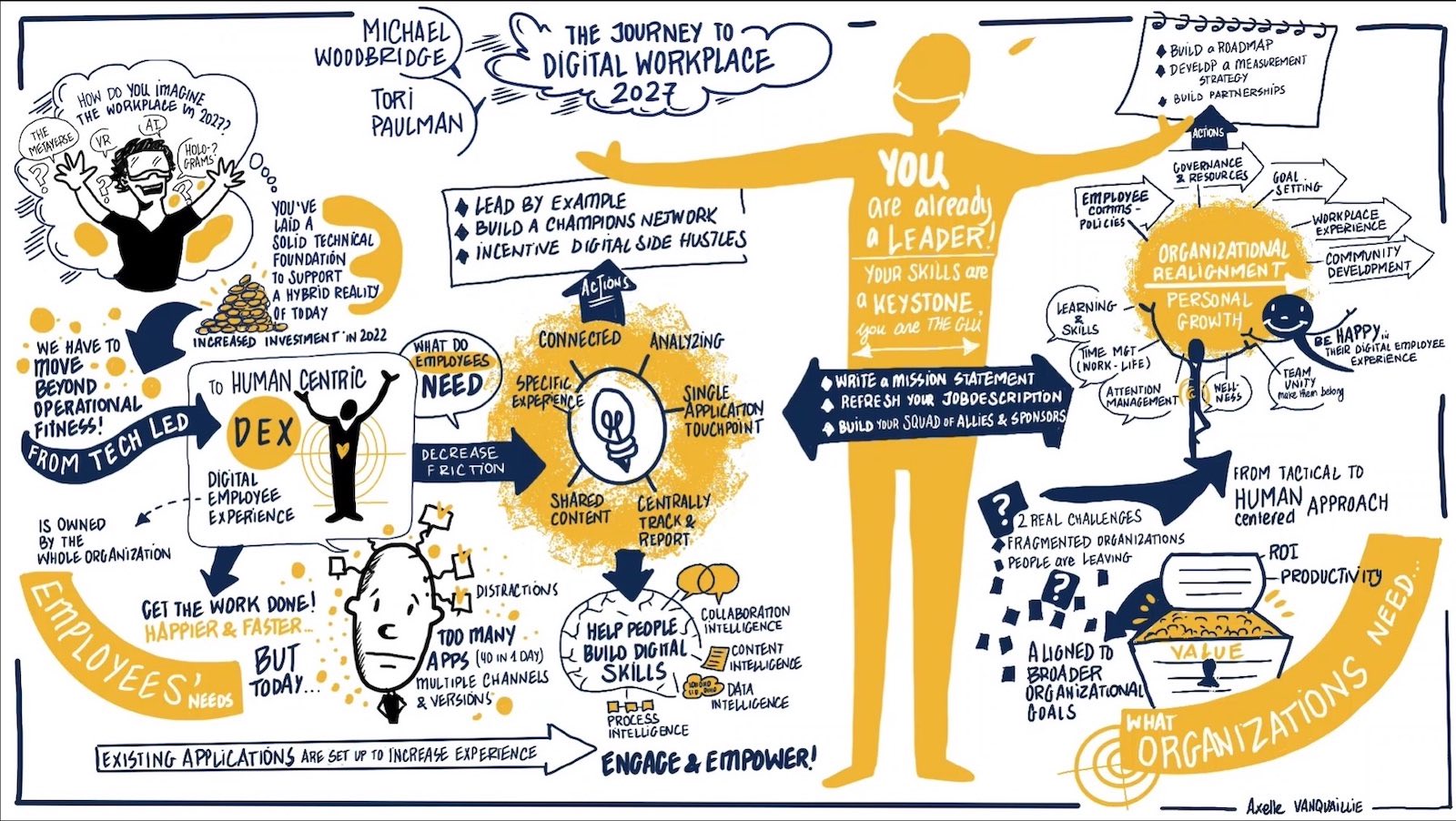I’ve spent the last few weeks meeting with individual analysts about Intranets and Portals, and the last two days in the Gartner 2022 Digital Workplace Summit. What I’ve learned so far is this space is newly interesting to many, struggles from too many granular tools, and (of course) there’s an opportunity here for Concrete CMS that many seem to be missing.
The exciting news is all of a sudden the C-suite cares about internal tooling. Gartner calls it “Employee Experience” or more specifically “Digital Employee Experience” (DEX because yes please, more acronyms.) Many of you may already be familiar with the idea of CEX, or “Customer Experience”, which models and monitors the entire lifecycle of a prospect as they become a customer and eventually a product evangelist. DEX is the same idea, but for your employees. What does it feel like to work here, and how can we make it feel better through improved technology and processes?
Apparently corporate America spent the last 10 years figuring out that if you care a little bit about your customer’s experience, it’s good for business. Now they’re wondering what amazing things will happen if they care about their employees a little bit more too! That’s healthy and natural, and probably well past time. I know growing up my Dad’s software company had old steel desks and terrible fluorescent lighting, and that never struck him as a problem. When I started working in the 90’s dot-com days anything less than an Aeron chair was embarrassing, and foosball tables were table stakes. I’m not sure that really helped achieve any goals, but if DEX means we’re going to start measuring the cost to productivity of people emailing documents around and never knowing where to find a good answer - that sounds like we might be on the right track to me.
The COVID pandemic and subsequent great resignation has thrown this natural evolution cycle into overdrive. People proved they could work from home, and they’re making it clear they don’t have to put up with a tedious work environment. According to Gartner, 26% of tech workers cite technology as a top value proposition in choosing where to work. The C-suite used to see the Internal Communication department as an afterthought, and information systems were driven by IT procurement. Now, with a distributed remote workforce that may only possibly become hybrid in part one day, keeping everyone on the same page about what the company is doing and making sure the tools used to manage those activities are efficient and delightful is of real value. Top executives are starting to list Employee Experience as a primary concern, even above Customer Experience.
So that’s the great news. There’s well deserved money and attention being spent on how we work together now that we’ve been forced to really adapt to a new distributed future.
As with all present tense revolutions however, the answer is not quite clear yet. There are a lot of useful working parts, but (at least to me) there isn’t a real elegant solution to the larger problem yet.
Employees consistently are plagued by Yet Another Tool To Check (YATTC) as various IT and managers add helpful solutions to the mix. On average, business users reported having to use 6-8 apps for a single business process. That sounds like a lot when read in a presentation, but last weekend I used way more than 8 tools to build a garden planter and that was a perfectly enjoyable process for me. The difference is my woodworking tools live in a toolbox and a shop where they are nicely organized (sometimes) so it’s easy for me to get them in the order and shape I need them in. I also know how to build stuff, so I wasn’t left wondering if I was using the right thing at every step in the process. The reality for a lot of employees in the corporate world is the tools they use every day are very disparate and unorganized, often without clarity around what is used for what. All of this resonates with me, as I’m sure it would to anyone who has joined an existing team of any size. There’s a lot of unique tribal wisdom in how any team actually gets things done.
That said, the digital tools available are actually working just fine. Microsoft 365 and Google Suite both do a tremendous job of making it easy to collaborate on creating documents and spreadsheets. It’s shocking to remember that my Dad’s software company used IBM Selectric typewriters to fill out forms, still in the 1980’s. He made sales presentations by rubbing Letraset letters onto transparencies and sending them to a service where they photographed them into slides for his actual slide projector. This was 35 years ago, not 135 years ago.
Now I can actively write and comment on a document in various views while people from around the world write at the same time, all while being connected over what amounts to phone lines. I can rework parts of my sales presentation seconds before I start the meeting. If you just reminisce for a moment about these older tools, now is clearly a pretty exciting time to be alive.
What we’ve done very well so far is build tools that help us create information, some of which is occasionally good enough to be called knowledge. Anyone can put their ideas down in a Google doc or spreadsheet and share it with anyone in the world with ease, and that’s downright amazing. But we’re missing similar attention to the bigger question of when and how to use that information to achieve our goals. Put more simply: we’re missing wisdom.
I have thousands of documents in Google Drive and the only way I can find any of them is by searching. Yeah, there’s a folder structure that we remind ourselves to be good about using, and that certainly helps, but it feels like a pretty antiquated way of organizing stuff. It’s like future product designers looked at my Dad’s office and said “that typewriter - what if there was an easy undo, everyone could type on any of them at once, and the document produced could look great and even have comments or a change history! BOOM!” Then they looked at the room full of filing cabinets where all this typed material lived and said “that’s good enough for organizing this stuff, we’ll just give you digital folders and head home.”
Gartner seems to see two answers to this problem, and I have another to offer.
The first big idea is Digital Workplace Platforms (DWP, because why not.) This is a single integrated employee experience where everything you need to do and know can be found. It’s not entirely clear that anyone knows what this means in the real world as even Gartner suggests you might find an actual tool like this in 1-2 years, and for now it's more of an architecture or mode of thinking. That said, it’s all about making your disparate apps share data, knowledge, processes and experience. So think of lots of APIs and SSO integrations along with some unified branding rules and vendors that actually improve their SaaS interfaces over time. That sounds pretty good to me, kind of like setting up a wood shop and deciding where the tools should go on a peg board.
There are a few players trying to deliver this new digital work environment from soup to nuts as well. Simpplr promises (in spite of their spelling) to make it easy for employees to do their jobs. They have all sorts of content types like calendars, polls, image galleries, and so on, and deliver it all in a scrolling feed a la Facebook. Speaking of, Meta has their own similar product geared for companies called Workplace.
This type of solution feels obvious at this point. Some people enjoy spending time on Facebook (still) and all social media revolves around this timeline approach to organizing information. When you think about the old ways that wisdom was managed in a physical office, you’ll find lots of examples where it amounted to knowing the right person to ask at the right time. Wisdom was tribal, and people who got things done did it through real life social networks built with cubical drop bys and shared lunches. If that worked for us for the last 100 years, surely we should just rebuild those interactions online with social media interactions to get the same or better results.
I think the jury is still out on this one, but I’m dubious. This feels like the “meh, filing folders is good enough” approach to problem solving to me. No one ever thought it was that efficient or wonderful that 2/3rds of your time in the office was spent chit-chatting with peers in trying to figure out who was the gatekeeper for whatever objective you had, it was just the best we could do with what we had available in the 20th century. To me, it seems likely that every company's private Facebook will become the stomping ground of suck ups and cheerleaders as the nuance, serendipity, and privacy of a cubical drop by or lunch for two is flattened out into a corporate managed feed. I can’t say I look at the results of the communication fostered by commercial social media as remarkably positive to date; are we really to believe it’s going to get better when you’re doing it “for the man?”
Furthermore, this unified approach will quickly feel like Yet Another Thing to Check very quickly. Metcalfe’s law means it will really only deliver on its underlying value promise if somehow everyone in the company really commits to using it. Spoiler alert, they won’t.
The other big idea is the magic of AI and ML and natural language processing. All we have to do is feed all of the content we’re making in Microsoft 365 or Google Suite into the huge graph database and we’ll end up with a possibly sentient (and if so understandably resentful) AI that can point us in the right direction when we type “how do i request vacation time…” into the official company chatbot that monitors our activity on every desktop. This answer actually feels slightly more hopeful than social feeds for business because we’ve all experienced this more or less working today. Google does a pretty good job of finding me the answers I’m looking for in the first page of results when searching the web. When I think of my user experience with Google Docs, it’s almost entirely using search (and recent.) It’s amazing how good it is at searching. If I know something exists in there, and I can remember a few specific words to it, I’ll find it. That’s good today and it’s only going to get better, so it seems that IT leaders who are building internal Elastic Search databases of summary content from many disparate corporate resources will likely see some rewards for their efforts.
It does strike me that much of Google’s magic actually has been delivered for free by the efforts of millions of humans who are putting content together and creating those precious backlinks. If it wasn’t for the masses of “20 top yadda yaddas” blog posts out there, Google would have a much harder time figuring out what I’m hoping for when I misspell a few words on my phone and magically still get an answer. I’ve certainly had the challenge of knowing that I wrote something in Google Drive somewhere, but not being able to find it, or the copy I thought I made….somewhere..
Without the manual curation, have we really made wisdom out of all this knowledge?
I live in Portland, Oregon, home of the largest new and used book store in the world; Powell’s Books.
Powell’s was actually very early to get on the web, selling books online before even Amazon. You can buy books from Powell’s online store. They have search, and it works well if you kind of know what you’re looking for, just like my Google Drive search experience does.
That being said, people still travel from around the world to visit Powell’s in person. It’s in every top tourist attractions list for Portland you’ll find. Meandering through Powell’s different genres organized by rooms is compelling. Looking at the books that the highly educated employees choose to curate together into an aisle ender is valuable. Sure, online I can read reviews that I can’t even see in the store. Still, something about the act of an experienced expert curating the right information together into a specific collection around an idea in an environment that feels emotionally engaging delivers a special kind of wisdom. We haven’t done a great job at recreating online, yet.
Which leads to my answer for this question of how do we do a better job of managing the process of working together. In addition to more search and easier to use tools – and yeah maybe even a social feed if chat isn’t enough – we need to rethink the category level. We’re doing a fine job making the detailed content, but we’re abdicating responsibility for the curation of content to algorithms we don’t even understand. There is an art to laying out a good front page to a newspaper, but we’re not giving content creators amazing tools for that job online. We let every department get away with adding their self proclaimed important content to the home page slider, and we hope people find what they need through search.
One analyst did earnestly claim “content management is a discipline before a technology,” mid way through a presentation, and it really resonated with me. Push comes to shove, it’s a lot easier to find your tools if you spend some time cleaning the shop and invest in a good pegboard. Sharepoint is a document repository and no one has ever sent me a Google Site as a starting point for understanding a complex process or organization.
I asked a friend recently how he organized everything for his climbing club. He told me there were a bunch of Google docs, and then a spreadsheet that he had put together that was a hybrid to-do meets Gantt chart. Spreadsheets were designed for accountants to organize numbers, why on earth have we not been able to deliver a better content management tool for organizing a bunch of content together than that? My friend is a sharp guy and knew he had to set aside some time to organize the information, or no one else in the club would be able to collaborate or eventually take over. As an industry we’ve failed in giving him tools to make it easy and delightful to bring this information together into a single attractive destination helpful to a new member of the team.
The great news is that Concrete CMS already does a pretty good job of this today, and we’re focused on making it wildly better. BASF has built several Intranets with Concrete and the value they see in using Concrete (vs. Sharepoint which they already have as part of Office 365) is that it’s actually enjoyable to use Concrete to build an attractive page summarizing a topic. You can take a few links to different systems, a few documents, some words of wisdom and a contact form and put that into an attractive page that follows BASF branding guidelines in just a few minutes. That hub of information is valuable.
It’s always a human author who realizes “Oh, I’d better spend a few minutes to put some of this stuff together so it makes sense later.” As a CMS, it’s our job to make sure that brave soul has tools that are easy to find and a pleasure to use. We need to help make the job of aggregating knowledge into wisdom a joy instead of a burden. We’ve done that for BASF, just listen to the lead there describe his team’s experiences using Concrete to manage their content.
We’ve got lots of small quality of life improvements that we’re constantly working on, and the last few weeks inspire us to double down on that type of improvement now. There’s opportunities to create more guidance around the content creation process within Concrete. We can make it even easier for that benevolent employee who is willing to do a little work to share a little wisdom in a sea of information.
If you’re interested in us thinking about your intranet challenges and helping to deliver your team tools that are a delight to use, we’d love to hear from you.



